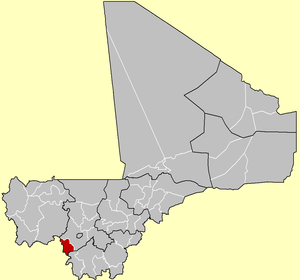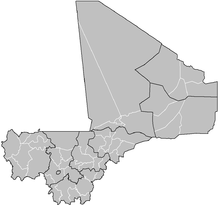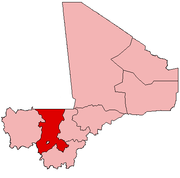
Koulikoro Region is a region in western Mali. It is the second administrative area of Mali and covers an area of 90,120 km2. Its capital is the city of Koulikoro.
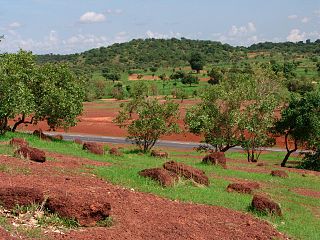
Kayes Region is one of eight first level national subdivisions in Mali called Regions. It is the first administrative area of Mali and covers an area of 120,760 square kilometres or 46,630 square miles. Its capital is the town of Kayes. The province was historically part of the Ghana Empire and the Mali Empire.
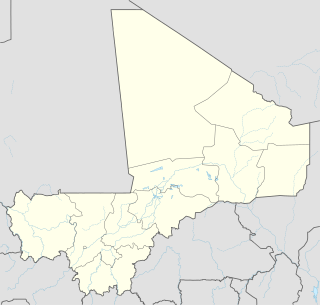
For the town in the Koulikoro Region see Kéniéba, Koulikoro

Kéniéba Cercle is a subdivision of the Kayes Region of Mali. The administrative center (chef-lieu) is the town of Kéniéba.

Nara Cercle is an administrative subdivision of the Koulikoro Region of Mali. Its seat is the town of Nara.

Koulikoro Cercle is an administrative subdivision of the Koulikoro Region of Mali. Its seat is the town of Koulikoro, which is also the capital of the region. A major trade and industrial town on the Niger River, Koulikoro has been surpassed by Kati to the west as the largest town in the region. Also to the southwest, lying entirely within Kati Cercle but administratively separate, is the District of Bamako, which after independence was carved out of the middle of the region.
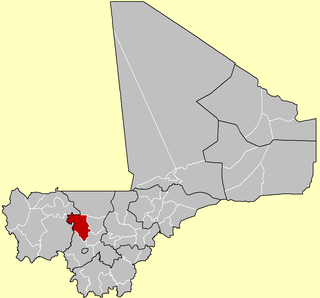
Kolokani Cercle is an administrative subdivision of the Koulikoro Region of Mali. Its seat is the town of Kolokani, which is also its largest settlement. It lies directly to the north of Kati Cercle. Also to the south, is the District of Bamako, which after independence was carved out of the middle of the Region. The cercle is further divided into communes.

Dioïla Cercle is an administrative subdivision of the Koulikoro Region of Mali. Its seat is the town of Dioïla. It lies at the southeast corner of the region, and prior to 1977, it was combined with what is now Kati Cercle and the District of Bamako in the "Bamako Cercle", with the capital city as its seat.
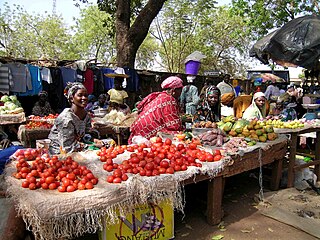
Sikasso Cercle is one of seven administrative subdivision of the Sikasso Region of southern Mali. The capital is the town of Sikasso.
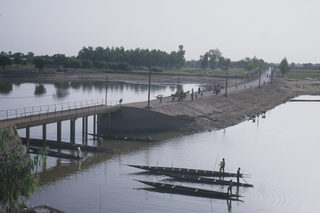
Djenné Cercle is an administrative subdivision of the Mopti Region of Mali. The administrative center (chef-lieu) is the town of Djenné. In the 2009 census the cercle had a population of 207,260 people.

Dégnékoro is a rural commune and village in the Cercle of Dioila in the Koulikoro Region of southern Mali.

Daban is a village and rural commune in the Cercle of Kati in the Koulikoro Region of south-western Mali. The commune is the most northerly of the cercle. It contains 11 villages in an area of 737 square kilometers and at the time of 2009 census had a population of 9,435. The village of Daban is 80 km northwest of Kati, the chef-lieu of the cercle.

N'Gouraba is a village and rural commune in the Cercle of Kati in the Koulikoro Region of south-western Mali. The commune covers an area of 579 square kilometers and includes 13 villages. In the 2009 census the commune had a population of 15,474. The village of N'Gouraba is 75 km southeast of the Malian capital, Bamako.

Yélékébougou is a village and rural commune in the Cercle of Kati in the Koulikoro Region of south-western Mali. The commune has an area of approximately 288 square kilometers and includes 16 villages. In the 2009 census the commune had a population of 7,257. The village of Yélékébougou is 30 km north of the town of Kati, the chef-lieu of the cercle.

Banko is a rural commune and village in the Cercle of Dioïla in the Koulikoro Region of south-western Mali. The village lies on the Banifing River. The commune contains 31 villages.

Dolendougou is a commune in the Cercle of Dioïla in the Koulikoro Region of south-western Mali. The main village (chef-lieu) is Dandougou.

Maramandougou is a rural commune in the Cercle of Kangaba in the Koulikoro Region of south-western Mali. The principal village lies at Figuira-Toma.

Benkadi is a rural commune in the Cercle of Dioïla in the Koulikoro Region of south-western Mali. The main village (chef-lieu) is Kotoula.

Diédougou is a rural commune in the Cercle of Dioïla in the Koulikoro Region of south-western Mali. The commune contains 34 villages. The administrative center (chef-lieu) is at the village of Béléko Soba which lies 205 km east of Bamako. In the 2009 census the commune had a population of 39,021.

Kéniéba is a small town and seat of the commune of Benkadi Habaladougou in the Cercle of Kangaba in the Koulikoro Region of south-western Mali.
